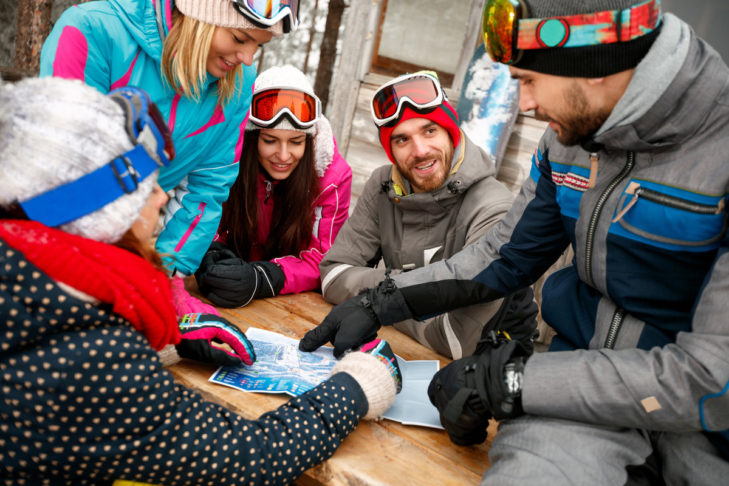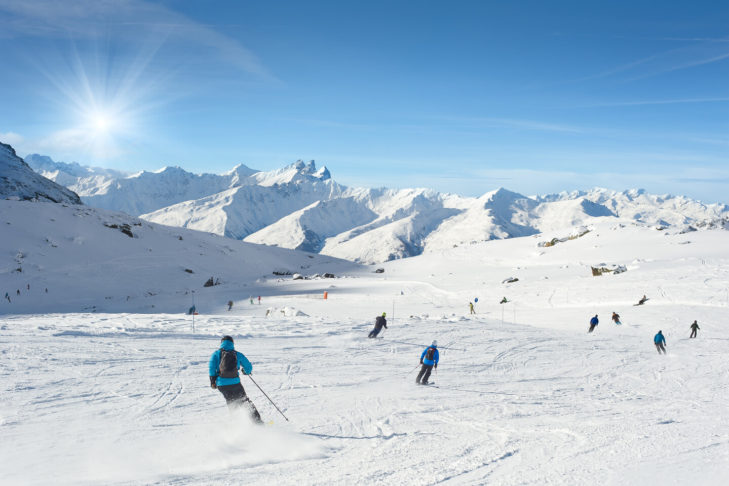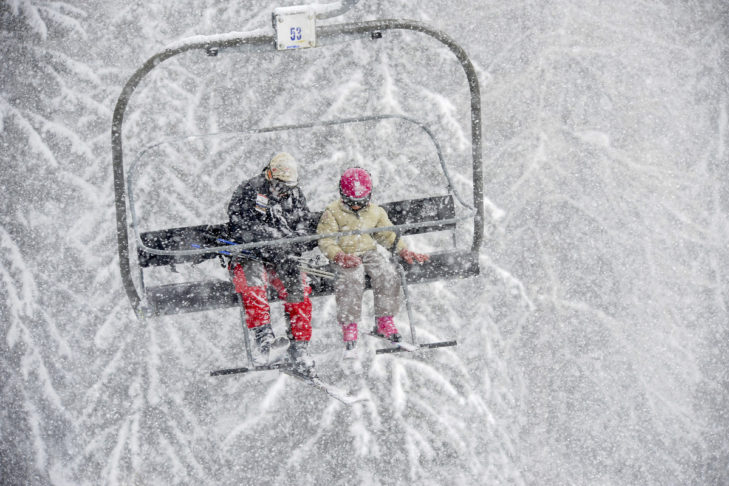The day starts with sunshine, it gets windy towards midday and snow falls in the afternoon – such weather changes are quite normal in the mountains. Visibility can also suddenly change from cloudy to foggy to sunny simply due to the altitude. This makes it all the more important for skiers to be prepared for changing visibility conditions so that they are always safe on the slopes. SnowTrex has put together some tips to help you understand the different conditions and adapt your skiing behaviour accordingly so that you can ski in poor visibility.
Whether it’s sunny or foggy: always be prepared on the piste
How safe you are on the piste is not only dependent on the external conditions. Safety starts with your own preparation. The more rested and fit you are, the better your ability to concentrate. If you ski attentively, you protect both yourself and others. Good preparation also includes knowing the terrain and the slopes well. If the weather suddenly changes and skiing becomes too dangerous, you can get to safety more quickly.
Before hitting the slopes, you should always check the weather forecast. It not only contains important information on temperatures and the weather situation, but also on visibility conditions. Weather apps for skiers such as iSki or Bergfex also provide a good overview. In general, the avalanche report should also be checked before setting off.
Exercise caution even in ideal conditions
Once on the piste, most skiers want the so-called ideal conditions. This includes sunshine for perfect visibility, temperatures that are neither too cold nor too warm and preferably a fresh layer of powder snow for a gliding ride.
However, it is precisely these perfect conditions that can also tempt you to be reckless and thus lead to accidents more quickly. Because it is so easy to ski in powder snow, many skiers ski at high speeds. The good visibility can also mean that you might not pay as much attention. What’s more, the slopes are particularly crowded in such conditions. All of this combined can lead to accidents and injuries even more quickly than skiing in poor visibility, because people generally ski more carefully in poor visibility.
Therefore, even when visibility is perfect: always ski carefully, attentively and considerately and preferably keep your speed down. Not only will you be safer when descending, you will also be able to enjoy the view of the landscape better.
Skiing in strong sunshine
But beautiful sunshine doesn’t just mean an unclouded view of the landscape. Especially when the sun’s rays hit the white snow, the sunlight reflects so strongly that you are quickly dazzled. This severely restricts visibility and is also dangerous for the eyes. Among other things, direct sunlight can damage the retina and lead to snow blindness, causing permanent damage to your eyesight. You should therefore never forget your sunglasses in strong sunshine.
We recommend glasses that also protect the sides of the eye from the sun’s rays. Dark glasses that are grey, blue or brown help best in strong sunshine. However, skiers should also pay attention to the glare protection value of the sunglasses. This is measured on a scale from zero to four. Level three is recommended for skiing.
Caution is also advised when the sun is low in the sky. Although it bathes the surroundings in a great light, the sun can also shine directly at eye level, especially if you are skiing toward it. Your eyes have to work extra hard to see anything. This saps your strength and requires a lot of concentration. If you notice that you can no longer see anything due to the low sun, it is better to take a short break, admire the landscape and only continue when the position of the sun is more favourable.
Skiing in cloudy conditions
In addition to dazzling sunlight, snowfall and fog can also affect visibility when skiing. This not only means that you can no longer see as far. The contours of trees or other skiers also become blurred and the piste is no longer as easy to recognise. Icy surfaces or steep slopes along the piste can quickly turn into unpleasant surprises.
As with strong sunlight, suitable ski goggles can help, as they make it easier to recognise outlines. Special bad weather goggles are available for this purpose. Your skiing style can also help you to reach the valley safely in poor visibility. This is because the weather often changes so quickly in the mountains that you have no choice but to ski in thick clouds or fog. The following tips will make your descent safer in poor visibility:
- Speed should always be adapted to the visibility conditions
- It is best to ski at an angle to the slope and turn in sharp bends
- Pay attention to the piste markings
- Avoid unfamiliar terrain and instead ski on familiar slopes below the tree line
- Better to stop too often than not often enough. This helps with orientation and you often make better decisions when you are stationary than when you are moving.
Skiing in snowfall
Of course there is no rule against skiing during snowfall. Many skiers even see the snow as a bonus, as it adds a new layer of powder snow with every new descent. The light also changes and the surroundings take on light grey tones. This can look beautiful, but can impair visibility.
In general, snowfall depends on the amount. A few flakes or light snowfall pose no danger. However, as visibility is impaired, it is important that you know the piste well. Ski goggles with a bad weather filter and a compass or GPS device can be helpful in these weather conditions.
If the flakes become so thick that visibility is severely impaired, you should not continue skiing. If you are close to the summit, you can take the lift back down, for example. If you are closer to the valley, you can ski diagonally against the slope to get down. This gives you more grip on the descent.
Skiing in fog
The word “fog” has Latin and Greek roots and means “cloud”. However, fog is actually a collection of water droplets close to the earth’s surface. If you can’t see more than a kilometre away, it is called fog. If visibility is less than 200 metres, it is heavy fog.
Fog is caused by a temperature difference between the ground temperature and the air temperature. Sometimes even minimal differences are enough to trigger dense fog. It is therefore particularly difficult for meteorologists to predict. Especially in the mountains, where temperatures fluctuate greatly, dense fog often forms out of nowhere. It is also possible that, due to the different altitudes, there is thick fog on one part of the piste and sunshine on another. It is therefore almost impossible to avoid fog when skiing, which is why it is so important to be well prepared.
As soon as visibility is restricted, you should slow down and ski with particular care and attention. This is because the piste then becomes no longer visible: the contours become blurred, making it difficult or impossible to recognise snow hills or slopes. Special fog goggles or ski goggles with a red tint, so-called blue blockers, can improve visibility with their contrasting colour to the monotonous white of the snow and blue of the sky. However, you should not rely on them too much, as they only help in light haze, but not in dense fog or even whiteout.
If the fog is very thick, you can easily lose your bearings. In this case, it can help to stop at safe places or at a crossroads and re-orientate yourself. In view of this, it is helpful to always have a piste map with you. That way, you won’t get lost so quickly, even when visibility is poor. It is generally advisable never to ski or snowboard alone. This is especially true in poor visibility. You should always ride in a group and stay close together so that you don’t lose anyone. If the fog becomes too thick, it is safer to stop briefly and wait until visibility improves.
Skiing in changeable conditions
Whether it’s snow or fog, weather conditions change quickly on the mountain. Every skier should expect this and actively factor it into their planning. This means that you sometimes have to react spontaneously to changes in the weather. The first descent may go smoothly, but if you suddenly find yourself in a fog bank on the second descent, it is advisable to change piste and not stick to one particular piste.
The weather apps mentioned above can help you find a better piste. Sometimes it is also a good idea to switch to a wider and therefore safer piste if visibility is poor. You can also ask the ski lift staff for advice. If necessary, it is safer to take a break and, for example, have a refreshing snack in a mountain hut. This allows you to rest briefly, recharge your batteries and continue skiing when visibility improves. If the weather doesn’t improve at all, it makes more sense to cancel the day’s skiing instead of risking injury on a descent in poor visibility.
Danger of whiteout
A whiteout occurs when there is snow on the ground and at the same time visibility is obscured by fog, snowfall or clouds. This means you have a layer of white below and above you: the light is reflected in such a way that the entire surroundings appear white. Even the horizon is no longer recognisable. As a result, it is impossible to distinguish up from down, or near from far. As a result, both orientation and balance can be lost.
A situation like this can be dangerous for winter sports enthusiasts if you don’t react properly. If this occurs during the descent and leads to a loss of orientation, you should stay together in a group. Continue travelling together very slowly or wait until the whiteout is over again.
If you feel safe, you can try to change terrain. The contrasting colours of trees or rocks can help to break up the whiteout and provide important points of orientation. A change in altitude can also help, as the whiteout often only occurs at certain points. The fog goggles also help to minimise the dangers of a whiteout.
The weather in the mountains is unpredictable and can change from one second to the next and from one altitude to the next. It is therefore important to always ski attentively and adapt your skiing style to the visibility conditions. However, if you are fit and rested, well prepared for the day’s skiing and exercise appropriate caution in poor visibility, you can ski safely even in poor visibility.
FAQ’s on visibility conditions
Why can sunny weather impair visibility?
The snow reflects the sun particularly strongly, which causes more glare when skiing. The low sun can also shine directly into your eyes, making it difficult to recognise clear contours when skiing downhill. Good ski goggles are therefore recommended.
What does snowfall have to do with visibility when skiing?
Light snowfall is very pleasant when skiing. However, when the flakes fall thickly, they can severely impair visibility, especially if they are whirled up by the wind. In this case, ski slowly and carefully. If visibility is too poor, you should either take the lift back down to the valley or wait in a mountain hut until the snow flurries subside.
Can you avoid fog?
Fog is an unpredictable weather phenomenon that occurs particularly frequently in the mountains. It is therefore almost impossible to avoid fog when skiing. However, with the right ski goggles, good local knowledge and careful skiing behaviour, you can find your bearings even in fog. If the fog is too thick, you should stop skiing and wait until the weather improves.
What can you do in changeable weather?
The weather in the mountains varies greatly. It can suddenly change from sunny to foggy or fluctuate from section to section. It is important that you always adapt your riding behaviour to the visibility conditions. If visibility is poor, you should ride slowly, stay in the group, stop more often, bend your knees and ride at an angle to the slope.
What is a whiteout?
A whiteout is a weather phenomenon that occurs when there is snow and flat light. In turn, flat light can form in snowfall, clouds or fog. When the white ground and the white sky meet, you quickly lose your orientation. The horizon becomes blurred, heights are no longer recognised and you can lose your balance. As this is very dangerous in winter sports, you should change terrain if possible during a whiteout or wait until visibility improves.









